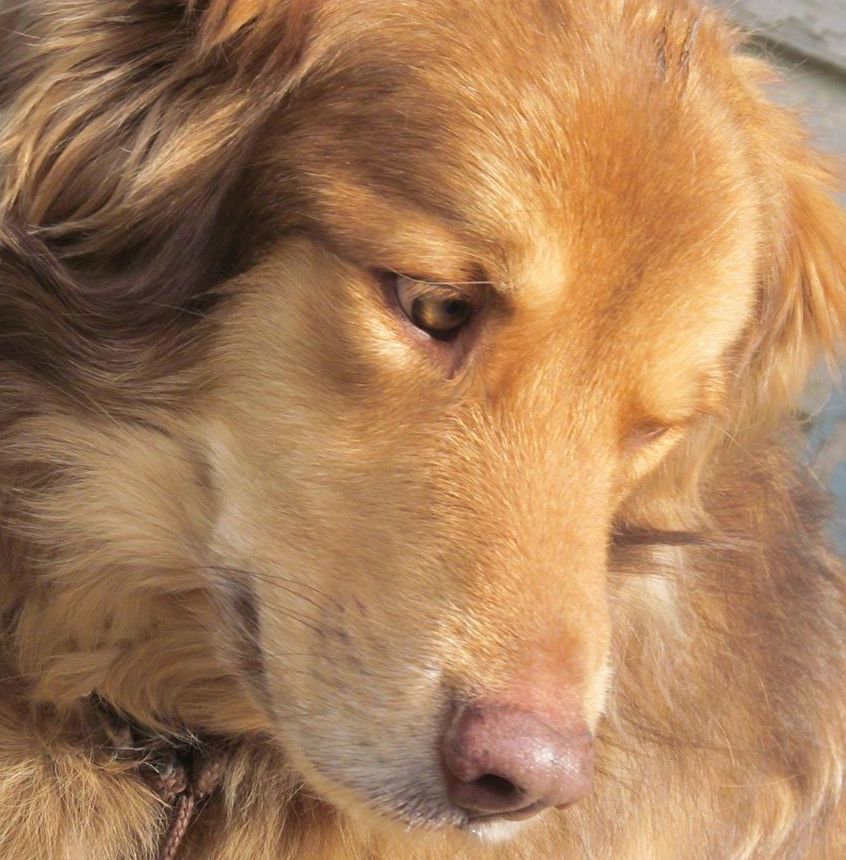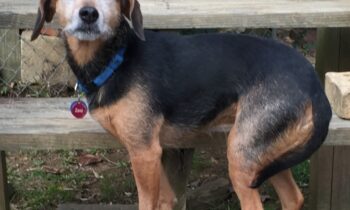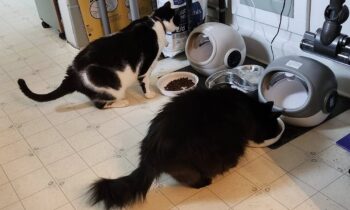
For the last few weeks, I’ve been working on training my younger dog to alert me to the whereabouts of my older dog. That behavior was suggested by a fellow trainer when I revealed that my older dog, now 15 years old, was losing both sight and hearing. She’s not deaf or blind yet, and she may never be. But her decreasing abilities to see and hear have made it difficult to find her when I need her.
Training the younger, larger dog—he’s 53 pounds, she’s five pounds—to find the older, smaller dog seemed like the perfect solution. Plus it would give the younger dog something useful to do around the house beyond cleaning the kitchen floor of crumbs (he’s expert-level at floor cleaning).
I made a plan, and I’ve been sticking with it, although, frankly, more things have gone wrong than have gone right so far. That is entirely my fault, of course. It can’t be their fault, as they have no idea what I’m hoping to teach them! They have, in fact, been extremely cooperative.
One thing that’s gone right is that my older dog is not at all uncomfortable with being in her little kennel close by where the younger dog is training. I thought before I started that it might be necessary to distract her with extra treats or possibly a frozen KONG in her crate, but she’s not bothered by the clicking, by the treats being tossed to the older dog, or by (most) attempts he makes at earning those clicks and treats. The older dog lies quietly, just watching.
I’ve also been extremely happy with the eager, willing attitude of my younger dog. I think he’d be happy “training” most of the day, although perhaps he would eventually be too full to take more treats. It’s not a hard job for him, being trained. There’s no downside. He enjoys it.
To make certain I don’t overfeed him with treats, I’ve measured and bagged a limited number for each training session. I don’t even have to look at the baggie to know how many are left; my fingers tell me as I reach in for the next one. When we’re almost out, it’s time to mark a good attempt and to jackpot with the remaining treats.
Then we take a break and both dogs go outside.

Is he making progress? He is, but the progress is slow. I’m constantly rethinking, wishing I could hit on a method that would make clearer to him the behavior I want. I’m seriously considering changing my plan. Would it be easier for him if I used the “target” concept, something with which he’s worked in the past? I could refresh his memory of the target stick, then use the target stick to ease him toward the other dog. Or I could use a target on the other dog . . . There are many possibilities.
For one thing, I’m not sure my choice of location for the initial training sessions was reasonable. Yes, it’s convenient—I can be sitting down or standing or even lying down (not that we’ve gotten to that point yet). It’s familiar to the dogs; it’s a place where they’re comfortable and nothing bad has ever happened.
But bringing training into the bedroom—in this case, a relatively small bedroom with a king-sized bed—means bringing food treats into the bedroom. I now know what had never occurred to me before: perhaps the bedroom is not the best setting for throwing around tiny pieces of meat and cheese?
Yeah, that.
I’m a pretty good thrower, especially of small treats. I’ve been perfecting that ability for years. I can land a minuscule square of cheese directly between the paws of a dog on a down, or shoot a tube-meat basket in the center of almost any dog’s open mouth, if he has his chin up. But, you know, tiny pieces of meat and cheese often have minds of their own and they do tend to . . . bounce. Far under the bed, for example, where the big dog can’t reach them.
Not that he’ll give up.
I learned quickly that the best thing to do when the treat skitters under the bed is to take the dogs outside, come back on my own, and dig it out with a broom—or let the little dog get it!
You might forget one tiny piece of meat or cheese under your bed, but your treat-obsessed dog Will Not Ever Forget it . . . until it’s gone. Leave it there and you’ll be awakened in the middle of the night by a dog much too big to fit under the bed trying to wedge himself in far enough to get his tongue to the treat. It’s like super Magic Fingers on a motel room bed or an earthquake not too far from epicenter. Don’t make that mistake.
Even worse is the phantom treat. I failed to find one last week, although I watched it fall. I thought it was on the floor under the lip of a medium-sized crate that was in the room temporarily to house a visiting dog. The crate sat empty a few feet from where I was. My dog followed the trajectory of the treat toss and clearly thought the treat had fallen into the crate. He immediately started trying to open the crate door to get inside. I unlatched the door, let him poke his head inside, looked myself. No treat. He then pushed the crate to one side, then the other, attempting to look under where the crate had been.
We never found that treat. He kept looking until I put the crate away.
I’m giving the bedroom location another week. If it’s still not working well enough, I’m going to move the whole training set-up to another spot in the house; probably the kitchen, for its open space and good vibes for the dogs. The older dog has never been kenneled in the kitchen, but she’s so used to being in her little crate anywhere—including in the car and at the theatre for rehearsals (she’s an actor)—that I doubt it will concern her to be in it on the floor in the kitchen. If it does, we’ll deal.
Additionally, I can see that the small space of the bedroom and my proximity to the dog dictated by that space makes it much more difficult for me to “look past” him without making direct eye contact. I want to avoid that because it might be intimidating or thwarting to his natural behavior. I have to watch him—the movement of his body—very closely, but I want to use my peripheral vision to do that. It’s awkward.
Who’s learning the most so far from every training session?
Me, of course.
Who’s having a good time each and every moment we train?
My dog, of course.
Who gets frustrated because it’s not happening fast enough?
Me.
Not the dog.
It’s not perfect because training often isn’t perfect, no matter where you start, no matter where you’re going. It’s a process; it has its ups and downs. I want my dog to be a genius and I get frustrated when he doesn’t “get it” within a couple of tries.
Luckily for him, I am mostly frustrated with myself—not, in this situation, with him. To help him to be better, I must be better myself.



